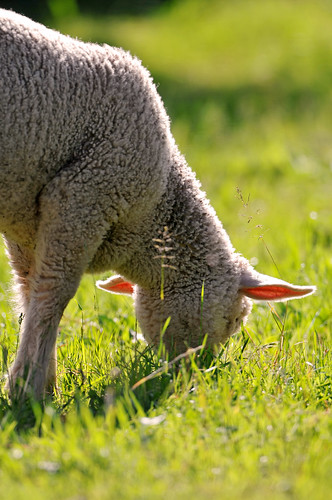Three Steps to Great Lamb
By Stanley A. Fishman, author of Tender Grassfed Meat

 photo credit: Tambako the Jaguar
photo credit: Tambako the Jaguar
Lamb is very unpopular in the United States. The amount of lamb in the diet of the average American has declined steadily. When I mention lamb to my friends, most of them say “I don’t like lamb.†This dislike is so intense that most of them will not even taste it.
Yet lamb is extremely popular and valued in all of Europe, the former Soviet Union, the Middle East, India, Australia, South America, New Zealand, in most of the world. In fact, lamb may be the world’s favorite meat.
Why do Americans dislike lamb? Why does the rest of the world love it?
The answer is very simple. The lamb eaten in the rest of the world is very different than most American lamb. There are two major differences.
First, American lamb is usually grain finished, while lamb in the rest of the world is almost always raised exclusively on grass.
Second, American lamb often comes from animals that are also used for wool. Lanolin, a substance present in sheep bred for wool, gives an unpleasant taste and smell to the meat. Most of the lamb eaten in the rest of the world comes from breeds raised for meat, not wool.
Grassfed Lamb Tastes Better
Most American lamb is “finished†on grain, in a feedlot. “Grain†usually means a mixture of GMO corn and GMO soy. This kind of grain is not the natural food of lambs, who are ruminants designed to live on living plants in the pasture, not processed grains.
Most of the lamb eaten in the rest of the world is fed grass only, and is never put in a feedlot.
This is a crucial difference, as the taste of lamb is heavily influenced by what the lamb is fed. For example, lambs raised in central Spain eat a number of herbs in the pasture, which gives a wonderful, herbaceous taste to their meat. Lamb raised in the salt marshes of Brittany is valued for its delicious meat, which has a slightly salty taste, from marsh plants growing in salty soil.
Lamb fed GMO corn and GMO soy has its taste altered by this feed. I consider the taste of such grain fed lamb to be awful.
Grassfed American lamb is wonderful. I have been fortunate enough to get lamb from the Willamette Valley in Oregon. This lamb has a wonderful flavor from some of the richest, greenest grasses in the world.
I have also been fortunate enough to get lamb raised on the Great Plains of the United States, which has grazed on the rich native grasses that were used to nourish the buffalo. The taste of this lamb is also wonderful, though it is different from the Oregon lamb, because the native forage is different.
Grain feeding, in my experience, makes the lamb greasy, with an unpleasant texture. One rancher described this lamb as tasting like “a great, greasy glob of nothing.â€
Grassfed lamb has a sweet, clean taste, redolent with the flavor of the living herbs and grasses eaten on the pasture. It is never greasy, and the texture is firm and tender.
The first step to eating great lamb—buy grassfed and grass finished only.
Lamb Bred for Meat Tastes Better
Humankind has developed many breeds of sheep over thousands of years. Some breeds were developed for their wool, which was used to make clothing. The wool and meat of these breeds contain a great deal of lanolin, a substance that smells bad and gives an unpleasant flavor to meat.
Breeds that have been developed for meat do not have lanolin, and their meat smells good and lacks the unpleasant flavor given by lanolin. Many of these meat breeds have a wonderful flavor and texture of their own, when grassfed.
Unfortunately, much of the lamb sold in the United States comes from breeds that are used both for wool and meat. This is the cause of the unpleasant smell and taste so many Americans associate with lamb.
Meat breeds smell good and taste better.
The second step to eating great lamb is to only buy lamb that was bred for meat, not wool. US Wellness Meats is a great internet source of grassfed lamb from breeds that have been developed for meat.
Traditional Cooking Means Great Lamb
Once you have grassfed and grass finished lamb, from a meat breed, you have to know how to cook it. Lamb is not difficult to prepare, but it is easy to ruin. There are many traditional ways of cooking grassfed lamb that are both easy and wonderful, and a number of them are in my cookbook, Tender Grassfed Meat.
The third step to having great lamb is to learn traditional ways of cooking it.
The Three Steps to Great Lamb:
- Buy only grassfed and grass finished lamb.
- Buy only lamb that is raised for meat.
- Learn how to cook this wonderful meat.
This post is part of Real Food Wednesday Blog Carnival at Kelly the Kitchen Kop.
This post is part of Monday Mania Blog Carnival at the Healthy Home Economist.
Sorry, the comment form is closed at this time.
Read more
« Traditional Barbecue Methods Avoid Risk Factors
The Pleasure of Pastured Pork »


 Photos of recipes from the new book Tender Grassfed Barbecue
Photos of recipes from the new book Tender Grassfed Barbecue
 Photos of recipes from the cookbook Tender Grassfed Meat
Photos of recipes from the cookbook Tender Grassfed Meat